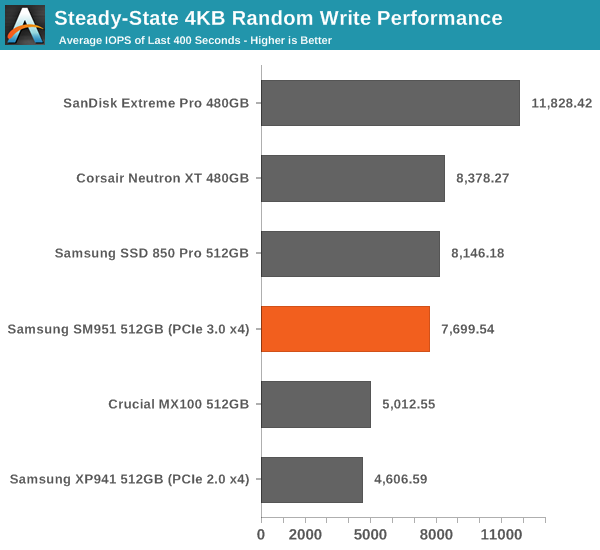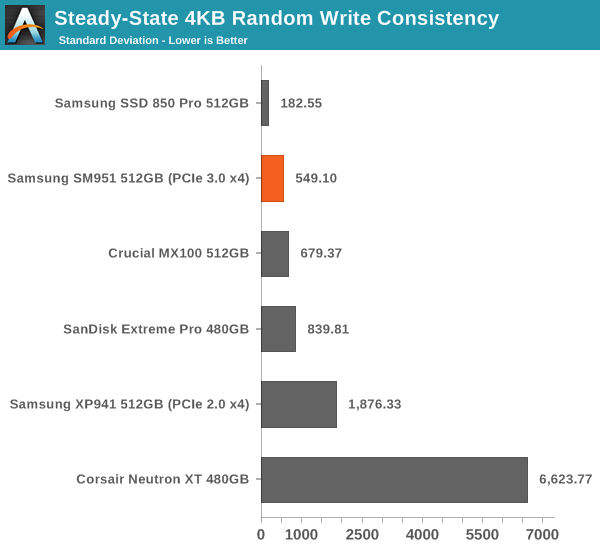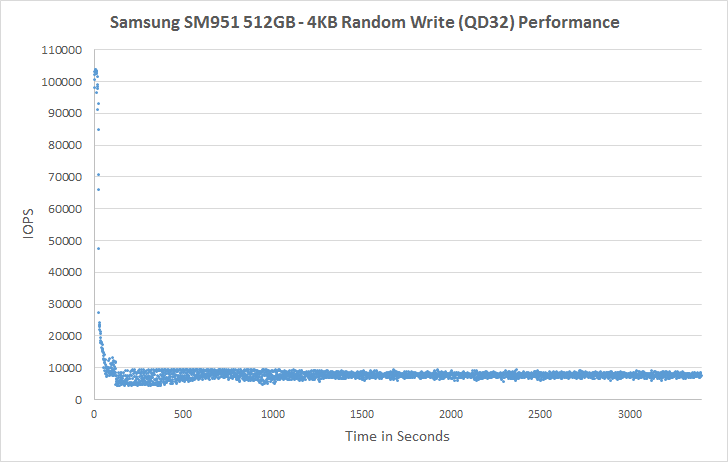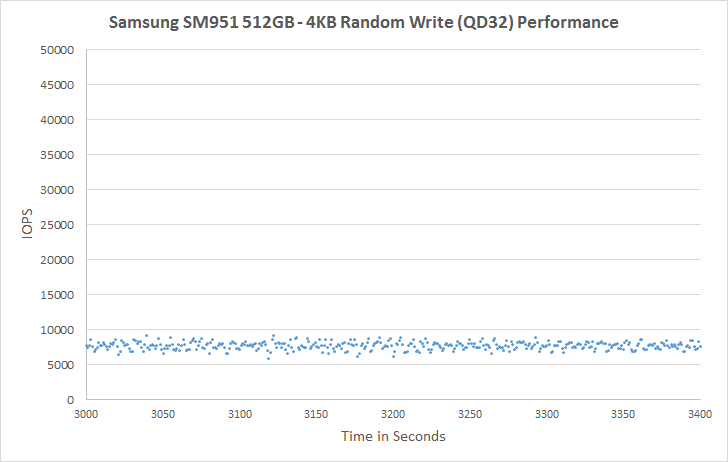Samsung SM951 (512GB) PCIe SSD Review
by Kristian Vättö on February 24, 2015 8:00 AM ESTPerformance Consistency
We've been looking at performance consistency since the Intel SSD DC S3700 review in late 2012 and it has become one of the cornerstones of our SSD reviews. Back in the days many SSD vendors were only focusing on high peak performance, which unfortunately came at the cost of sustained performance. In other words, the drives would push high IOPS in certain synthetic scenarios to provide nice marketing numbers, but as soon as you pushed the drive for more than a few minutes you could easily run into hiccups caused by poor performance consistency.
Once we started exploring IO consistency, nearly all SSD manufacturers made a move to improve consistency and for the 2015 suite, I haven't made any significant changes to the methodology we use to test IO consistency. The biggest change is the move from VDBench to Iometer 1.1.0 as the benchmarking software and I've also extended the test from 2000 seconds to a full hour to ensure that all drives hit steady-state during the test.
For better readability, I now provide bar graphs with the first one being an average IOPS of the last 400 seconds and the second graph displaying the standard deviation during the same period. Average IOPS provides a quick look into overall performance, but it can easily hide bad consistency, so looking at standard deviation is necessary for a complete look into consistency.
I'm still providing the same scatter graphs too, of course. However, I decided to dump the logarithmic graphs and go linear-only since logarithmic graphs aren't as accurate and can be hard to interpret for those who aren't familiar with them. I provide two graphs: one that includes the whole duration of the test and another that focuses on the last 400 seconds of the test to get a better scope into steady-state performance.

In steady-state performance the SM951 provides a substantial ~70% upgrade over the XP941 and brings performance nearly to the same level with the 850 Pro. Given that the 850 Pro uses faster V-NAND, the steady-state performance is a pleasant surprise and shows that the SM951 is more than a marginal bump from the XP941. Obviously, drives with more default over-provisioning (i.e. Extreme Pro and Neutron XT) provide higher steady-state performance, but Samsung is doing very well with the default 7% over-provisioning.

The consistency of the SM951 is also great. The Neutron XT is a living proof of a drive with high average IOPS, but horrible consistency because as we can see in the graph above its standard deviation is up to dozens of times higher compared to the other drives. That's just not acceptable for a modern drive, especially because there are many drives that can consistently provide high IOPS.
 |
|||||||||
| Default | |||||||||
| 25% Over-Provisioning | |||||||||
For a dozen seconds or so, the SM951 is actually able to burst out 100K IOPS, but the performance soon drops to below 10K IOPS and eventually evens out at ~7.5K IOPS. The SM951 is very consistent and doesn't experience any notable IOPS drops, whereas the XP941 regularly drops to a few hundred IOs per second. Increasing the over-provisioning to 25% brings the IOPS to about 35K, which is very decent and again much better than the XP941 that still has odd drops in performance.
 |
|||||||||
| Default | |||||||||
| 25% Over-Provisioning | |||||||||










128 Comments
View All Comments
blanarahul - Tuesday, February 24, 2015 - link
Can't wait to see what Intel brings to the table considering the amount of focus they put on consistency.extide - Tuesday, February 24, 2015 - link
I'm not sure that we will see anything too interesting client side from them. They seemed to have moved all their focus to the enterprise side, which is of course where the bulk of the money is.FWIW, Intel already has a PCIe SSD that is arguably faster -- the Intel SSD DC P3700
dylan522p - Tuesday, February 24, 2015 - link
Is, not arguablyStuka87 - Wednesday, February 25, 2015 - link
It is faster, and certainly more reliable. Intel has the best enterprise SSDs on the market.FunBunny2 - Wednesday, February 25, 2015 - link
-- Intel has the best enterprise SSDs on the market.Among consumer facing companies, perhaps. The real enterprise SSD/flash players are largely unknown to AnandTech and its readers.
monsted - Wednesday, February 25, 2015 - link
I'd love to see the results of a HDS FMD compared to the usual suspects.Kristian Vättö - Wednesday, February 25, 2015 - link
We've had this conversation before and I'll tell you this again: the majority of flash array vendors are using SSDs from Intel, SanDisk, Samsung and others. There are some that design and build their own drives/blades (e.g. Violin and Skyera), but the vast majority is using third party drives as the heart of their flash arrays.GTVic - Wednesday, February 25, 2015 - link
All drives now should support eDrive.Railgun - Tuesday, February 24, 2015 - link
At the rate I'm going, I'll end up with one of these before my XP941 ever gets powered up once, retail or otherwise.Laststop311 - Tuesday, February 24, 2015 - link
Disappointed in lack of 1TB size/ no 3d vnand/ no nvme. I planned on using 1 of these in 1TB size for a boot drive for a skylake-e build. The good news is I have a couple years for samsung to fix those issues.